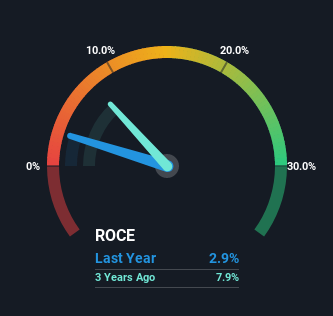Investors Could Be Concerned With Newlat Food's (BIT:NWL) Returns On Capital
What are the early trends we should look for to identify a stock that could multiply in value over the long term? Firstly, we'd want to identify a growing return on capital employed (ROCE) and then alongside that, an ever-increasing base of capital employed. Basically this means that a company has profitable initiatives that it can continue to reinvest in, which is a trait of a compounding machine. Having said that, from a first glance at Newlat Food (BIT:NWL) we aren't jumping out of our chairs at how returns are trending, but let's have a deeper look.
What Is Return On Capital Employed (ROCE)?
If you haven't worked with ROCE before, it measures the 'return' (pre-tax profit) a company generates from capital employed in its business. The formula for this calculation on Newlat Food is:
Return on Capital Employed = Earnings Before Interest and Tax (EBIT) ÷ (Total Assets - Current Liabilities)
0.029 = €15m ÷ (€809m - €292m) (Based on the trailing twelve months to December 2022).
Thus, Newlat Food has an ROCE of 2.9%. In absolute terms, that's a low return and it also under-performs the Food industry average of 8.6%.
Check out our latest analysis for Newlat Food

In the above chart we have measured Newlat Food's prior ROCE against its prior performance, but the future is arguably more important. If you'd like to see what analysts are forecasting going forward, you should check out our free report for Newlat Food.
SWOT Analysis for Newlat Food
- Earnings growth over the past year exceeded the industry.
- Interest payments on debt are not well covered.
- Annual earnings are forecast to grow faster than the Italian market.
- Trading below our estimate of fair value by more than 20%.
- Debt is not well covered by operating cash flow.
What Does the ROCE Trend For Newlat Food Tell Us?
In terms of Newlat Food's historical ROCE movements, the trend isn't fantastic. Around five years ago the returns on capital were 9.1%, but since then they've fallen to 2.9%. However, given capital employed and revenue have both increased it appears that the business is currently pursuing growth, at the consequence of short term returns. If these investments prove successful, this can bode very well for long term stock performance.
On a side note, Newlat Food has done well to pay down its current liabilities to 36% of total assets. So we could link some of this to the decrease in ROCE. What's more, this can reduce some aspects of risk to the business because now the company's suppliers or short-term creditors are funding less of its operations. Some would claim this reduces the business' efficiency at generating ROCE since it is now funding more of the operations with its own money.
The Bottom Line
In summary, despite lower returns in the short term, we're encouraged to see that Newlat Food is reinvesting for growth and has higher sales as a result. These trends are starting to be recognized by investors since the stock has delivered a 9.8% gain to shareholders who've held over the last three years. So this stock may still be an appealing investment opportunity, if other fundamentals prove to be sound.
If you'd like to know about the risks facing Newlat Food, we've discovered 1 warning sign that you should be aware of.
While Newlat Food isn't earning the highest return, check out this free list of companies that are earning high returns on equity with solid balance sheets.
Valuation is complex, but we're here to simplify it.
Discover if NewPrinces might be undervalued or overvalued with our detailed analysis, featuring fair value estimates, potential risks, dividends, insider trades, and its financial condition.
Access Free AnalysisHave feedback on this article? Concerned about the content? Get in touch with us directly. Alternatively, email editorial-team (at) simplywallst.com.
This article by Simply Wall St is general in nature. We provide commentary based on historical data and analyst forecasts only using an unbiased methodology and our articles are not intended to be financial advice. It does not constitute a recommendation to buy or sell any stock, and does not take account of your objectives, or your financial situation. We aim to bring you long-term focused analysis driven by fundamental data. Note that our analysis may not factor in the latest price-sensitive company announcements or qualitative material. Simply Wall St has no position in any stocks mentioned.
About BIT:NWL
NewPrinces
Engages in the agri-food sector in Italy, Germany, the United Kingdom, and internationally.
Undervalued with adequate balance sheet.
Market Insights
Community Narratives


Recently Updated Narratives


MINISO's fair value is projected at 26.69 with an anticipated PE ratio shift of 20x


The Quiet Giant That Became AI’s Power Grid


Nova Ljubljanska Banka d.d will expect a 11.2% revenue boost driving future growth
Popular Narratives


The company that turned a verb into a global necessity and basically runs the modern internet, digital ads, smartphones, maps, and AI.


MicroVision will explode future revenue by 380.37% with a vision towards success



